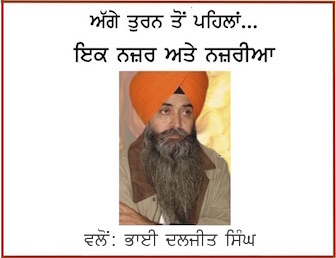Articles/Opinion
“Operation Blue Star” – The clash of Civilizations
June 5, 2014 | By Avtar Singh
30 years on- the wounds are still simmering; the pain is still deep embedded in the minds and hearts of the Sikhs. The injustices of that period are still haunting Sikh psyche. The idea of ‘Forgetting as survival mechanism’ unleashed by Indian state is still pricking the Sikh soul.
After 30 years Sikhs are still on the crossroads of uncertainty. Uncertainty about their past, and uncertainty about the future relation with Hindu civilization. Sikhs are silently commemorating those, who laid down their lives to protect their holy shrines. As Chinese people are not allowed to commemorate the martyrs of Tiananmen Square massacre, Indian state is similarly trying to stifle the voice of Sikh dissent. It is not happening through the security apparatus of Indian State but with the help of media as well.
![[File Photo]](http://www.sikhsiyasat.net/wp-content/uploads/June-1984-Akal-Takht-Sahib.jpg)
[File Photo]
30 years ago Indian troops launched an assault code named ‘Operation Blue Star’ on the holiest shrine of Sikhs- the Harmandir Sahib in the pretext of flushing out Sant Jarnail Singh Bhindrawale and his ardent followers from that complex. Thousands of pilgrims and a handful of militants were killed in that attack. Much has been written in this context. Books of some senoir journalists, officials and army Generals were published to justify the attack on Harmandir Sahib.
On the 30th anniversary of the bloodiest attack on Sikh psyche, lot more has been written in Indian media. The tragedy of this political and intellectual exercise is that it lacks the global vision about the main causes of the conflict. It is mainly revolving around the rivalry between Indira Gandhi and Sant Jarnail Singh. The clash of personalities was not the root cause of the conflict. Indira Gandhi and Sant Jarnail Singh were the representatives of oppression and resistance respectively. The root cause of this conflict was there in the history of Indian civilization.
The roots of the Sikh- Indian conflict lies with the formation of Indian State after Independence. The idea of Nationalism forwarded by Indian nationalists before and after Independence was contrary to Sikh ethos and culture. Although there are lot of quotations available we will refer Professor Bipin Chandra’s views in this context. He said;
‘Colonial India has to be studied as a nation in the making both as an objective process and as the subjective cognition of this process…the national movement was the process through which the Indian people were formed into a nation and a people….it was the existence of common oppression by common enemy and the struggle against it which provided important bonds uniting the Indian people….’
As G.Aloysius said the becoming of a nation and setting up of a state system are two things; the transportation of nation with state is one of the confusions that recent sociological scholarship has sought to dispel.
Now the crisis of Indian State is that after Independence- newly formed India was locked in unrelenting ethnic, intra-religious and linguistic sectarianism. Due to this sectarianism it was left to patriotic officials, politicians and army men to encourage the Hindusisation of India as an overarching national narrative, in a sense to glue country together using politicised religion as a new form of national identity.
In this context we are going to quote Antonio Gramsci an Italian intellect about the idea of nationalism and hegemony.
For Gramsci, the class that seeks to create a national synthesis around its leadership ought to hegemonize the other classes of the population; its present or future rule has to be, and genuinely appear to be, not merely class rule of one class over others but a national- popular rule. The crucial concept within this set of ideas is of course hegemony which refers to the nature of the relationship between the leading class and the masses.
So Gramsci has clearly elaborated the idea of nationalism via hegemony.
Indian state and its actors were on the course of building this hegemonic- nationalism to glue the country and to dispel or decimate the sense of dissent by repression or by assimilation.
The conflict was evident due to the political ideology of Indian state or its politicians.
Actually the important task for Indian leadership after Independence was to initiate a consensus building approach to bridge the relationship with ethnic minorities of India. To redress their concerns and to cement the apparently irreconcilable differences. To establish good working relationship with ethnic minorities. Instead Indian leadership adopted another path of Nation Building via hegemony.
In the nation building process, due respect should be given to human yearning for symbolism, familiarity and cohesion, as Huntington said, ‘flags count and so do the symbols of cultural identity, including crosses, crescents, and even head coverings, because culture counts, and cultural identity is what is most meaningful to most people.
For Sikhs it was their religious and cultural identity which was most meaningful to them.
No nation state can be built on elite hegemonic ideology as the new global political ideology is predicting a multipolar and multicivilizational world. Samuel P. Huntington elaborated this by saying, a civilization based world order is emerging; societies sharing cultural affinities cooperate with each other; efforts to shift societies from one civilization to another are unsuccessful.’
This is the root cause of all the global conflicts including India. Indian state is trying to shift its society from one civilization to another. It is using every state apparatus from army to intelligence and from politics to media and intellectuals to change the course of multicivilized India. The roots of India- Sikh conflict can be traced in this stubbornness of Indian elite.
Henry Kissinger in one of his lecture about the future of global political discourse noted that, ‘in the new world order, local politics is the politics of ethnicity; global politics is the politics of civilization.’
The whole world order is changing now. Non western societies, particularly in East Asia, are developing their economic wealth… As their power and self-confidence increase, non-Western societies increasingly assert their cultural values and reject those ‘imposed’ on them by the West.
So this imposition of the cultural and religious values by Indian elites on the ethnic minorities was and is the main cause of conflicts arising in present India.
Operation Blue Star was the first ever attempt by minorities to resist the hegemonic nationalism of Indian state. The Clash of Civilizations happened years before the theoretical interpretation of the global world order. It has far reaching affects on Indian and global polity and political ideology. The lessons should be learned from this conflict for the future management of political affairs. It should not be debated in political terms but should be viewed in ideological aspects also.
* Avtar Singh may be reached at: singhavtar9412 (at) gmail (dot) com
To Get Sikh Siyasat News Alerts via WhatsApp:
(1) Save Our WhatsApp Number 0091-855-606-7689 to your phone contacts; and
(2) Send us Your Name via WhatsApp. Click Here to Send WhatsApp Message Now.
Sikh Siyasat is on Telegram Now. Subscribe to our Telegram Channel
Related Topics: 1984 Sikh Genocide, Indian State, June 1984 attack on Sikhs, Operation Bluestar




